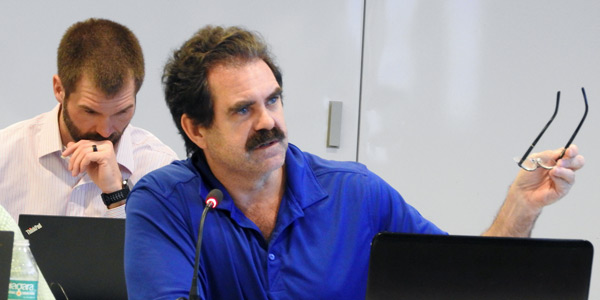VALLEY FORGE, Pa. — Power demand proved difficult for PJM operators to forecast in March as a snowstorm was followed by exceptionally warm weather, RTO staff told participants at last week’s Operating Committee meeting.
“That was the story of March: a lot of up and down,” PJM’s Chris Pilong said.
The balancing authority area control error limit (BAAL) performance score dipped to 99.4%, the lowest it’s been since last March, PJM’s Ken Seiler said, with 257 excursion minutes. The BAAL was high in some cases, suggesting that plants were over-generating, he said. The longest excursion lasted nine minutes.
“This is eerily similar to what we had last year,” he said.
A 24-minute spinning event on March 23 occurred when market-to-market constraints in MISO prevented PJM from loading combustion turbines from the west, as the RTO had planned, Pilong said. PJM is looking at the event to determine which units responded and which did not, Seiler said.
PJM’s perfect dispatch performance is 76%, which is about six percentage points lower than it was at this time last year.
PJM Wants to Study Frequency Response
PJM is proposing a problem statement and issue charge to understand why many generating units either aren’t providing frequency response or are responding incorrectly to signals from the RTO.
While frequency response is essential for grid reliability, a 2012 NERC report found that only 30% of units were providing primary frequency response, PJM’s David Schweizer said. FERC published a Notice of Proposed Rulemaking on the topic in November that would require all new units, excluding nuclear, to provide the service. The commission is considering the comments it received. (See FERC Seeking Comments on Primary Frequency Response.)
In a survey of its generators last year, PJM found that, among its critical load resources — generators with a four-hour or less hot start time — just 95% have a functional governor, 75% are using NERC-recommended settings and 25% are using controls that override frequency response.
Other grid operators, including CAISO, MISO and ISO-NE, have requirements consistent with NERC reliability standards, PJM said.
The new rules, which PJM would be looking to implement for all units, would comply with NERC standards and might also include compensation, even though the NOPR didn’t propose that.
PJM had suggested separating the components across the Operating and Market Implementation committees, but stakeholders were adamant that they should be kept together to ensure any market signals are designed to incent the desired behavior.
A PAR Too Far?
PJM and NYISO are still interested in replacing a broken phase angle regulator at Consolidated Edison’s Ramapo substation, despite stakeholder skepticism about its necessity. The grid operators are holding a meeting Tuesday at NYISO’s offices to discuss the situation and consider modifying their joint operating agreement. The joint stakeholder interactions are intended to create criteria for a benefits analysis that would factor in the cost allocation of any remedies. (See PAR Wars: A Struggle for Power.)
PJM’s Stan Williams walked through a presentation NYISO created on the issue, in which the ISO urges replacing the PAR.
“They see enough benefit there that they want to move ahead with replacing the second PAR by the fall,” he said.

Borgatti | © RTO Insider
Williams said the joint stakeholder engagement will be beneficial as it might create a roadmap for future cross-border projects. PJM uses a similar benefits analysis with MISO in determining transmission, he said. Gabel Associates’ Mike Borgatti asked PJM to develop a presentation on how that process works.
Carl Johnson of the PJM Public Power Coalition and Calpine’s David “Scarp” Scarpignato complained about the PAR meeting being scheduled on one of PJM’s only two no-meeting days of the month. Both said they will be unable to attend.
“You’re going to have a one-sided meeting. It only happens once a month,” Scarp said.
Dave Pratzon of the GT Power Group supported PJM’s engagement with NYISO on the issue, pointing out that the RTO objected when MISO attempted to make PJM pay for PARs installed on the Michigan-Ontario border.
PJM Seeking Feedback on Fuel-Security Report
Vice President of Operations Mike Bryson walked through a paper PJM released last month on fuel security in the RTO and asked for stakeholder feedback. (See PJM: Increased Gas Won’t Hurt Reliability, Too Much Solar Will.)
Although the paper found a capacity mix of more than 20% solar would threaten reliability, Bryson noted that currently renewables only make up about 2% of the mix.
The paper was very narrowly focused, he noted, and purposefully didn’t address other topics, such as environmental issues or whether natural gas infrastructure could keep pace with the high percentage of gas-fired generators PJM’s analysis said the fleet could handle. The paper did not identify a percentage of gas-fired units that would threaten reliability.
Additionally, it didn’t consider dual-fuel units or units with access to multiple fuel pipelines. It also assumed that all units had confirmed supply contracts.

Scarpignato (right) and Keech | © RTO Insider
FirstEnergy’s Jon Schneider pointed out that the study highlighted only a third of the portfolios that PJM considered “desirable” would be resilient enough to withstand polar vortex-type conditions, which the study attributed to “the increased risk of natural gas delivery under extremely cold and high load conditions.” He asked for clarity on assumptions made regarding gas supply since it can be either firm or interruptible.
Bryson acknowledged that the study assumed firm service for all units and said that the results would factor into PJM’s planning going forward.
Scarp said many gas units have access to multiple pipeline sources and that, despite coal units maintaining a 30-day onsite fuel supply, many such piles were frozen and unusable during the 2014 polar vortex and recalled a similar period in 1994 that resulted in rolling blackouts.
“Just because you have a 30-day inventory doesn’t mean you have supply for 30 days,” he said.
— Rory D. Sweeney



